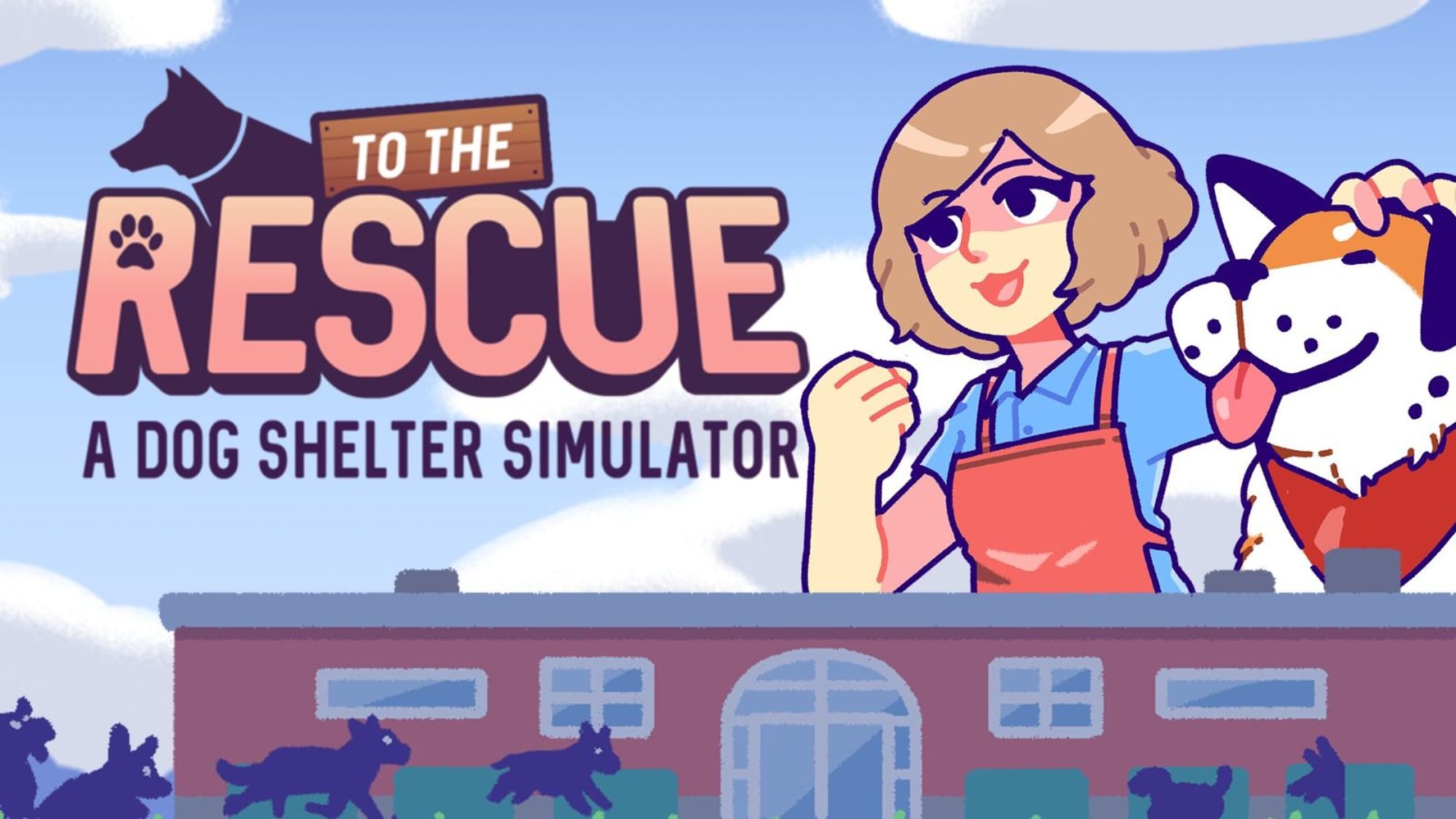Run a digital dog’s home and help find forever homes for canine companions in To The Rescue! from Little Rock Games. The Finger Guns Review.
There’s a long and storied relationship between man’s best friend and video games. Whether it’s the plethora of games that have you care for a dog, like Dogz or Nintendogs, or those that have recruitable 4 legged companions, such as Skyrim, Fallout or Far Cry, gaming and canines have a huge history together. Hell, there’s even a very popular twitter account dedicated to games that let you pet the dogs. Despite having nearly 40 years of history together, I don’t think there has ever been a dog-centric title quite like To The Rescue!, the debut video game from Little Rock Games, published by Freedom Games. Here, you design, manage and run a dog shelter.
As I learnt during my preview session with this game, To The Rescue is inspired by a series of real world events that occurred to some of the Little Rock Games team. In the game, you play as a player created character (chosen from a series of pre-sets) who has just moved to the city alongside their puppy pal (again, chosen by the player). As they unpack their boxes, the pair hear barking coming from their garden. It’s a stray dog that’s energetically bounding around in their yard. There’s no collar and the local dog’s home is full, so the protagonist takes them in while they search for the dog’s owner. Having plastered the local dog park in posters, the lost dog is quickly reunited with its owner. A happy ending. Inspired by these events, the protagonist decides to help out at the local shelter. A few days later, having impressed the manager of the dog’s home, the mayor of the city arrives and offers the protagonist the manager role of a new shelter that they’re setting up.
You build this shelter from the ground up. It’s initially an empty shell with nothing but the essentials to get you going, sans any kennels which you pick and place yourself which also dictates your capacity. As you progress, you can expand the building and redesign the layout of the rooms to be as efficient as possible. This is all done from a design view which can take a bit of getting used to and even then, is a tad clunky.
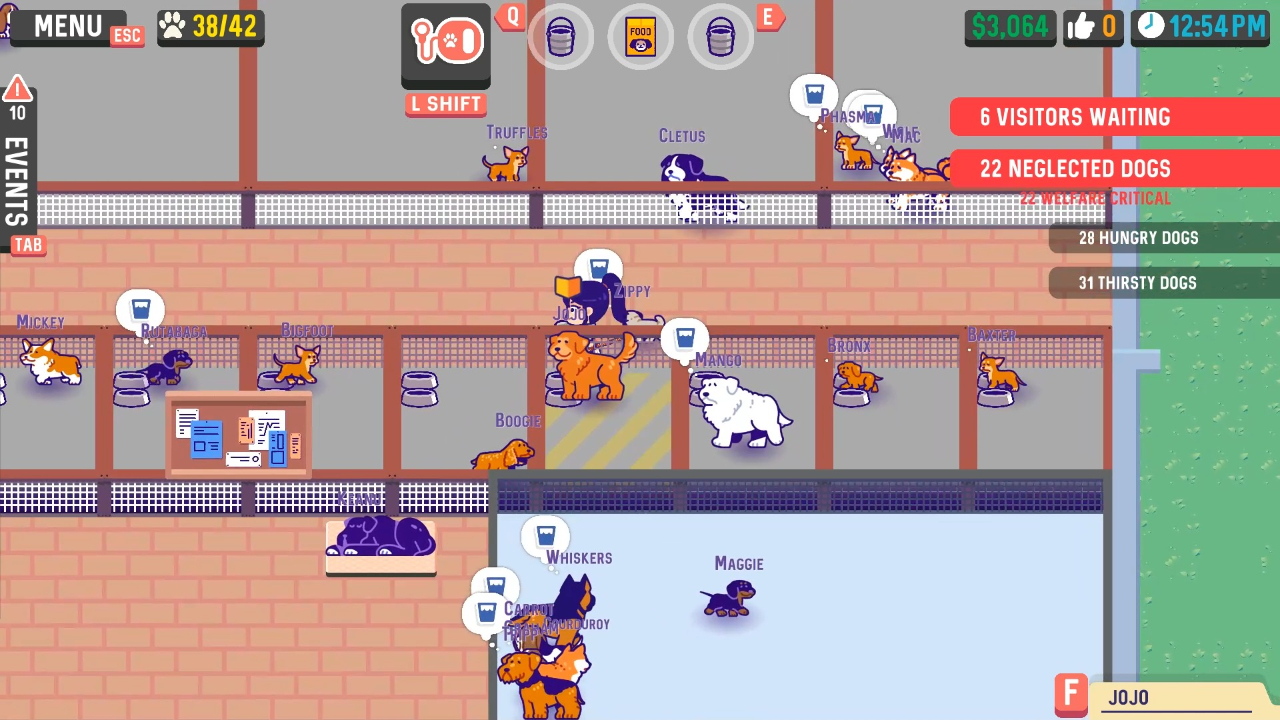
The opening story chapter of the game acts a whistle-stop tour/tutorial to looking after dogs. Each dog that arrives at the shelter is unique, identified via a named file that can be viewed with a click of a button. Of course each dog needs water and food, but each dog has a preference of what type of nibbles they like. Dogs being dogs, they’ll wolf down whatever food you give them – but if it doesn’t agree with their stomach, they’ll quickly fill their housing with poops. Picking up their mess with a pooper scooper is also essential. The longer a dog is in their kennel with their poo, the quicker they get dirty. You’ll need to bath and brush each animal eventually, but how regularly will depend on how well you keep on top of cleaning their living space.
Even when they’re fed, watered and clean, it’s important to consider a dog’s unique quirks too. Many kennels allow you to put 2 or more dogs together. Some dogs don’t get on with other puppy pals and others have conflicting traits, like putting a loud dog with a jumpy dog. If you mix up pooches with competing needs, they will get stressed out (something you’ll notice in the way they move in their area) and their happiness will fall. Play time in the garden can usually sort that out, which takes the form of a mini-game. Balancing all of this – making sure they’re watered, fed the right type of food, that they’re clean and happy – becomes quite the task. What’s more, you’ve got to do all of this on a budget, for which you’re responsible. There’s only so many hours in a day and once the rescue is closed, any time you spend seeing to your canine community is paid as overtime.
If To The Rescue has taught me anything, it’s a new appreciation for those that run real world dog shelters. Managing to keep everyone happy and health can feel overwhelming at times, especially if you try to expand too quickly. It’s like spinning a bunch of plates, only these plates are furry, they can be quite picky about which other plates they spin next too and will occasionally crap all over the place. This game is never as stressful as when there’s a disease outbreak in your home. Quarantining the infected away from those dogs that are not yet sick is a quick fix to stop the spread but no matter what you do, it’s likely to be an expensive and potentially damaging to your reputation. I’ll be honest, the first time this happened to me, I didn’t handle it very well. Almost all my dogs were infected and I didn’t have the resources to solve the issue in the way I wanted. I simply closed my laptop and walked away until the next day. Thank God dog for daily auto-saves.
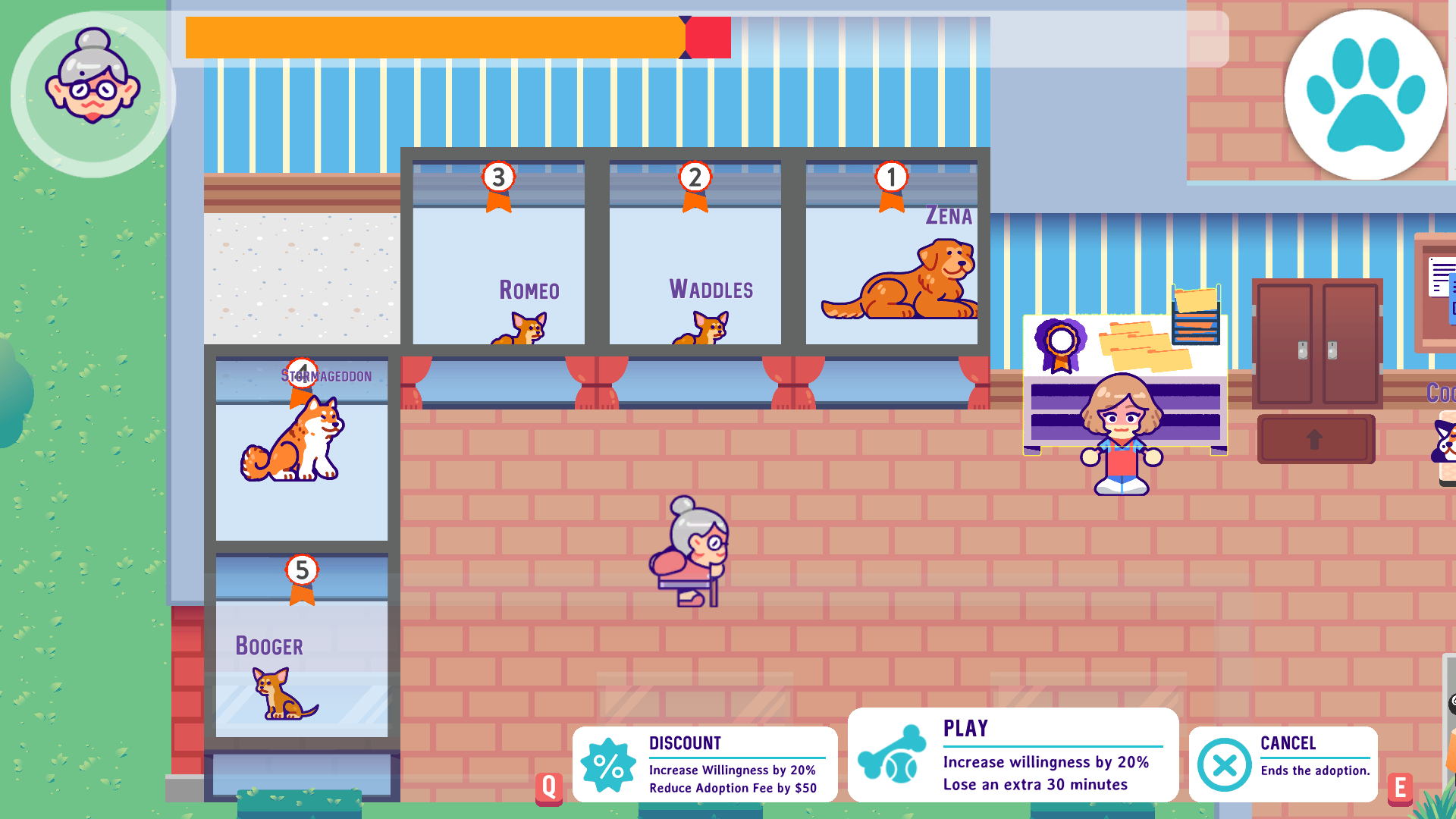
The overarching aim of To The Rescue is to find forever homes for the canine castaways that are left in your care. Prospective new owners will arrive at your rescue and will wait in the lobby. They each have a pre-set resistance to adopting a dog and, more often than not, have an ideal dog in mind. Some will come in and simply say “I want to adopt a dog” while others have certain demands like “A small dog with allergies” or “a large dog that’s good with kids”. Regardless of what type of dog a potential owner is after, no single dog will be able to sway them. It’s a team effort to woo them into adoption that takes the form of another mini-game.
Once a potential new owner has outlined what type of dog they’re looking for, it’s up to the player to find up to 5 dogs that match those criteria. This isn’t essential – if a person is looking for a medium sized dog and you’ve only got one in your kennels, you can still select 4 other dogs – but the closer a dog is to a person’s desired traits, the more they’ll help convince them to adopt a dog. These 5 dogs are put in a holding area and the prospective owner then comes along and checks out each one in turn. The happier, cleaner and more well looked after a dog is, the more they contribute to the adoption process. This is gamified as a star system that is combined for all 5 of the dogs that are put out to show. If the combined star score of all 5 dogs is higher than the resistance a potential owner has to adoption, they’ll choose a dog from the quintuple to take home, making a monetary donation to the rescue in the process. What’s quite clever here is that the new owner might go home with a dog that’s nothing at all like the dog they came to adopt. There’s probably some RNG going on in the background but my headcanon is that they simply fell in love with a dog that wasn’t at all what they were looking for and picked them anyway. It’s the way life works sometimes. I personally once went to rescue a German Shepherd and came home with a Shih Tzu who needed our care more. It happens.
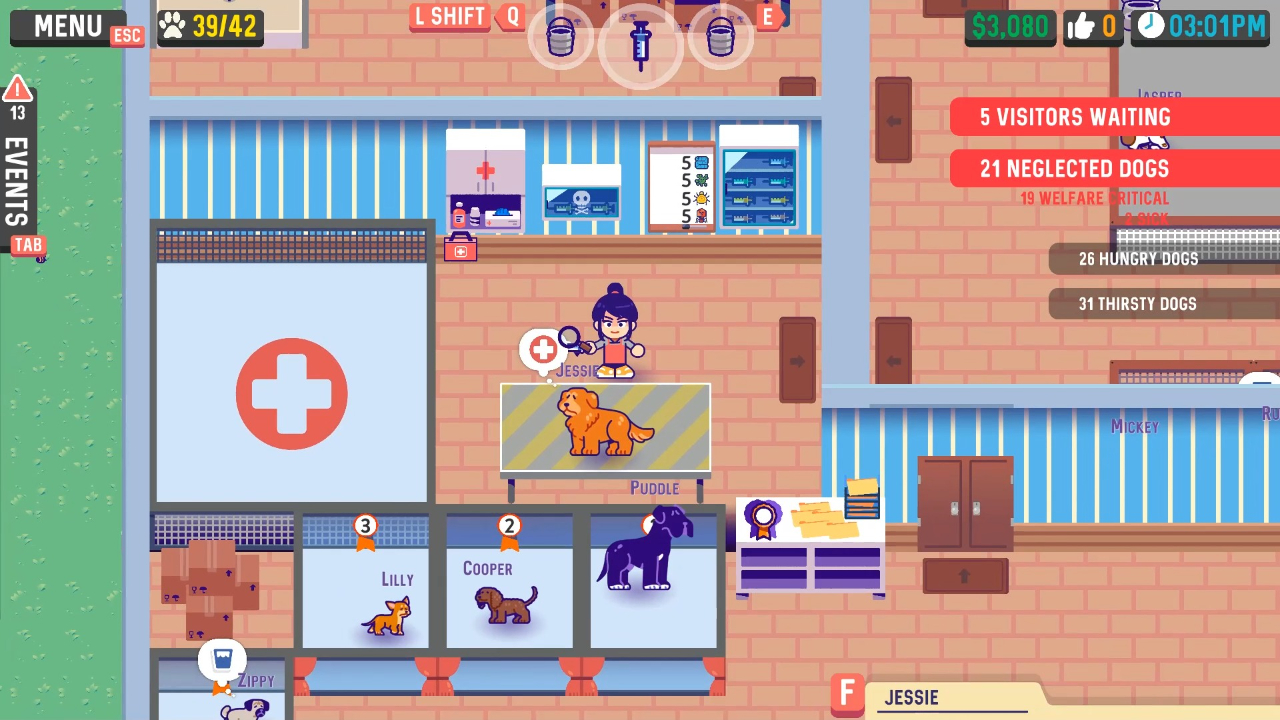
While managing the rescue can be stressful at times, it’s often worth it for these moments of triumph. As the game progresses, the dogs become more complex and you’ll find some puppers just get passed over time and time again, despite meeting the necessary criteria. When these dogs finally find a home, especially the older ones with issues that make them difficult to deal with in a rescue, it’s a really touching conclusion. These dogs might be just a collection of pixels roaming around on the screen but for dog people, these moments feel great.
While there’s pleasant moments to be had in To The Rescue, there can be challenging moments too, should you want there to be. The ability to euthanize dogs is an option you can turn on or off when starting your game. Even if you choose to have this setting turned on, you can still run a ‘no kill shelter’ but there’s considerations to be made. Some dogs can be difficult to care for, with extensive behavioural issues, and if you’re running short on cash, you’ll have difficult decisions to make. The same can be said about disease outbreaks. If heartworm breaks out in your rescue, you’ll have choices to make – do I go into debt treating all of these dogs or do I make the difficult choice? Little Rock Games wanted To The Rescue to present the full spectrum of feelings generated by running a dog’s home, including the eye brow raising, arduous ones. They’ve succeeded.
One feeling that Little Rock Games probably didn’t want to generate with To The Rescue was annoyance. Unfortunately, there are a large number of bugs and a few core design issues which can make this game feel laborious and frustrating to play. The biggest annoyance that this title regularly lays on the player is its clunky and unintuitive UI system. If you’re using a laptop track pad without a scroll wheel instead of a mouse, don’t bother playing To The Rescue. Without a mouse scroll wheel, you’ll feel like you need 3 hands to play this game effectively. This hasn’t helped when there’s an odd and irregular delay when trying to pick up or drop items. Then there’s the notification system. Important messages are presented along the left side of the screen and stack – but unless you’re addressing them and deleting them regularly, you’ll sometimes miss things. I’ve had big red text messages arrive on screen to say that a dog is currently neglected, only to find it is a new arrival that I hadn’t even know had been dropped off at my rescue.
Oh, and the bugs. Like fleas on an untreated mutt, they’re everywhere. I’ve had dogs hungrily roaming around the rescue after somehow spacing through a kennel wall, I’ve had them stuck in the sides of a kennel and I’ve had them saying they’re desperately thirsty despite standing next to a full water bowl. When I finally hired some staff to help with all the daily chores, they can get snagged on the environment and have spent the day doing nothing. Not only was this a waste of money paying for their wages but the dogs were in such a state that I ended up paying out a huge amount of overtime as I try to fix the mess created by their inactivity.
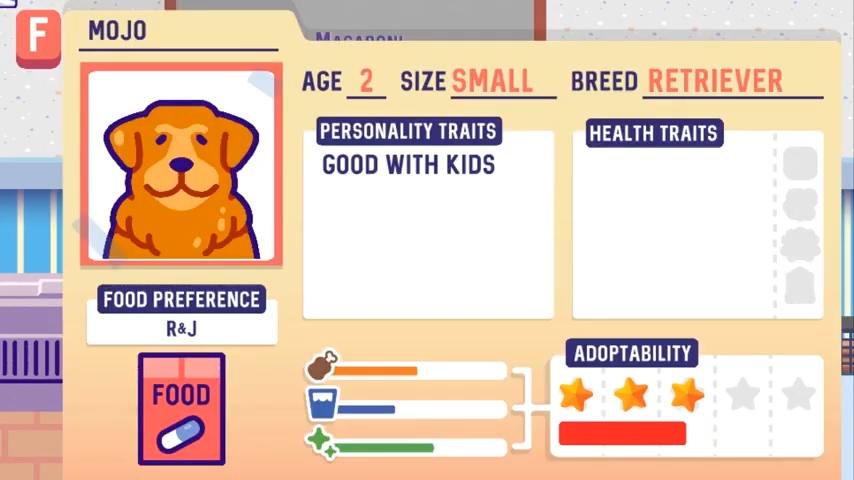
The core design issue I found with To The Rescue is that it’s regularly just too fiddly for its own good. The player character can only carry 2 items at a time which means that there’s often quite a lot of backtracking to do in order to swap what you’re carrying. I understand the need to have a limited inventory to add some semblance of realism. But when you’ve got a rescue full of dogs that each need something from you, it feels like such an inconvenience to to have to walk back to the hook so you can swap out a bucket or pooper scoop instead of simply putting it down. The fact that the three most important and regularly used implements are right next to each other, and 60% of the time you’ll accidentally pick up the wrong one, it just annoying.
Even with its issues though, the core loop in To The Rescue is involved enough to keep you coming back game day after game day. The periods between glitches can be fun and rewarding. Especially on those days when you manage to find new forever homes for the digital dogs that have made a temporary home in your thoughts.
As of version 1.0.7 of the game, there’s a number of mildly frustrating bugs and issues which take the shine off of To The Rescue! Hopefully, Little Rock Games has the opportunity to patch these as beneath its hiccups, it feels like there’s a good game here. The concept is cute and original, the art style is clean and the game play loop can be quite moreish, so long as you can push though its core annoyances.

To The Rescue! is launching on PC via Steam on November 4th, 2021.
Developer: Little Rock Games
Publisher: Freedom Games
Disclaimer: In order to complete this review, we were provided with a promotional copy of the game. For our full review policy, please go here.
If you enjoyed this article or any more of our content, please consider our Patreon.
Make sure to follow Finger Guns on our social channels –Twitter, Facebook, Twitch, Spotify or Apple Podcasts – to keep up to date on our news, reviews and features.
